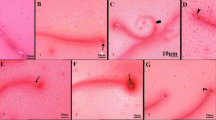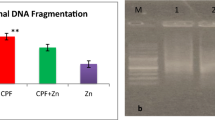Abstract
The 2,4-dichlorophenoxyacetic acid (2,4-D) is used worldwide in agriculture as a selective herbicide. It has been shown to produce a wide range of adverse effects on the health of both animals and humans from embryotoxicity and teratogenicity to neurotoxicity. In the present study, we have examined the effect of 2,4-D on male reproductive function of rats. Male Wistar rats received daily by force-feeding 100 or 200 mg of 2,4-D/kg body weight for 30 consecutive days. Rats exposed to 100 and 200 mg of 2,4-D/kg showed a significant decrease in body weights only after 24 days of treatment and in relative weights of testis, seminal vesicles and prostate at killing day, when compared with controls. Moreover, a decrease in testosterone and an increase in FSH and LH serum levels were detected in treated rats. Besides, exposure to this herbicide induced pronounced testicular histological alterations with enlarged intracellular spaces, tissue loosening and dramatic loss of gametes in the lumen of the seminiferous tubules. In addition, a decreased motility and a number of epididymal spermatozoa with an increased sperm abnormality rate were found in treated rats in comparison with control. With the highest dose, histological observations of seminal vesicles indicated a considerable decrease of secretions in the lumen, a thinness of the muscle layer surrounding the epithelium with branched mucosal crypts and reduced luminal space. In prostate, the heights of the cells decreased while acinar lumen were enlarged and they lost the typical invaginations. Our results suggest that a subacute treatment of 2,4-D promotes reproductive system toxicity.





Similar content being viewed by others
References
Abarikwu SO, Akiri OF, Durojaiye MA, Adenike A (2015) Combined effects of repeated administration of Bretmont Wipeout (glyphosate) and Ultrazin (atrazine) on testosterone, oxidative stress and sperm quality of Wistar rats. Toxicol Mech Methods 25(1):70–80. doi:10.3109/15376516.2014.989349
Amer SM, Aly FA (2001) Genotoxic effect of 2,4-dichlorophenoxyacetic acid and its metabolite 2,4-dichlorophenol in mouse. Mutat Res 494:1–12
Anway MD, Leathers C, Skinner MK (2006) Endocrine disruptor vinclozolin induced epigenetic transgenerational adult onset disease. Endocrinology 147(12):5515–5523
Bertheussen K, Yousef MI, Figenschau Y (1997) A new sensitive cell culture test for the assessment of pesticide toxicity. J Environ Sci Health B 32:195–211
Bian Q, Qian J, Xu L, Chen J, Song L, Wang X (2006) The toxic effects of 4-tertoctylphenol on the reproductive system of male rats. Food Chem Toxicol 44(8):1355–1361
Bradberry SM, Watt BE, Proudfoot AT, Vale JA (2000) Mechanisms of toxicity, clinical features and management of acute chlorophenoxy herbicide poisoning. Clin Toxicol 38:111–122
Bruce WR, Furrer R, Wyrobek AJ (1974) Abnormalities in the shape of murine sperm after acute testicular X-irradiation. Mutat Res 23:381–386
Bukowska B, Kopka A, Michalowicz J, Duda W (2006) Comparison of the effects of Aminopielik D pesticide and its active components on human erythrocytes. Environ Toxicol Pharmacol 22:189–193
Burns CJ, Swaen GMH (2012) Review of 2,4-dichlorophenoxyacetic acid (2,4-D) biomonitoring and epidemiology. Crit Rev Toxicol 42(9):768–786. doi:10.3109/ 10408444. 2012.710576
Charles JM, Cunny HC, Wilson RD, Bus JS (1996) Comparative subchronic studies on 2,4-dichlorophenoxyacetic acid, amine, and ester in rats. Fundam Appl Toxicol 33(2):161–165
Charles JM, Hanley TR Jr, Wilson TR, van Ravenzwaay B, Bus JS (2001) Developmental toxicity studies in rats and rabbits on 2,4dichlorophenoxyacetic acid and its forms. Toxicol Sci 60(1):121–131
Dantas TA, Cancian G, Neodini DN, Mano DR, Capucho C, Predes FS, et al. (2015) Leydig cell number and sperm production decrease induced by chronic ametryn exposure: a negative impact on animal reproductive health. Environ Sci Pollut Res Int 22(11):8526–8535. doi:10.1007/s11356-014-4010-5
Faqi AS, Dalsenter PR, Mather W, Heinrich-Hirsh B, Chahoud I (1998) Reproductive toxicity and tissue concentration of 3, 3′4,4′ tetrachlorobiphenyl (PCB 77) in male adult rat. Hum Exp Toxicol 17:151–156
Fawcett DW (1986) Male reproductive system. In: Bloom W, Fawcett DW (eds) A textbook of histology 11th edition. WB Saunders, Philadelphia, USA, pp. 796–850
Ferri A, Duffard R, Stürtz N, Evangelista de Duffard AM (2003) Iron, zinc and copper levels in brain, serum and liver of neonates exposed to 2,4-dichlorophenoxyacetic acid. Neurotoxicol Teratol 25:607–613
Galimov SN, Valeeva GR (1999) Effect of 2,4-D ecotoxicants on spermatogenesis and fertility of albino rats. Aviakosm I Ekoloq Med 33:32–34
Hauser R, Altshul L, Chen Z, Ryan L, Overstreet J, Schiff I, et al. (2002) Environmental organochlorines and semen quality: results of a pilot study. Environ Health Perspect 110:229–233
Huynh PN, Hikim AP, Wang C, Steonovic K, Lue YH, Leung A (2000) Long-term effect of triptolide on spermatogenesis, epididymal sperm function and fertility in male rats. J Androl 21(5):689–699
Johnson L, Dickerson R, Safe SH, Nyberg CL, Lewis RP, Welsh TL (1992) Reduced Leydig cell volume and function in adult rats exposed to 2,3,7,8-tetradibenzodioxin without a significant effect on spermatogenesis. Toxicology 76(2):103–118
Joshi SC, Tibrewal P, Sharma A, Sharma P (2012) Evaluation of toxic effect of 2,4-D (2,4-dichlorophenoxyacetic acid) on fertility and biochemical parameters of male reproductive system of albino rats. Int J Pharm Pharm Sci 4(3):338–342
Kang IH, Kim HS, Shin JH, Kim TS, Moon HJ, Kim IY, et al. (2004) Comparison of antiandrogenic activity of flutamide, vinclozolin, proc130 ymidone, linuron and p,p-DDE in rodent 10-day Hershberge assay. Toxicology 199(2–3):145–159
Kavlock R, Cumming A (2005) Mode of action: inhibition of androgen receptor functionvinclozolin, induced malformation in reproductive development. Crit Rev Toxicol 35(8–9):721–726
Krzanowska H (1976) Inheritance of sperm head abnormality types in mice and the role of the Y chromosome. Genet Res 28:189–198
Lerda D, Rizzi R (1991) Study of reproductive function in persons occupationally exposed to 2,4-dichlorophenoxyacetic acid (2,4-D. Mutat Res 262:47–50
Littorin M, Hansson M, Rappe C, Kogevinas M (1994) Dioxins in blood from Swedish phenoxy herbicide workers. Lancet 344(8922):611–612
Liu RC, Hahn C, Hurtt ME (1996) The direct effect of hepatic peroxisome proliferators on rat Leydig cell function in vitro. Fund Appl Toxicol 30:102–108
Majumder GC, Biswas R (1979) Evidence for the occurrence of ecto (adenosine triphosphatase) in rat epididymal spermatozoa. Biochem J 183:737–743
Palmeira CM, Moreno AJ, Madeira MC (1995) Thiols metabolism is altered by the herbicides paraquat, dinoseb and 2,4 D: a study in isolated hepatocytes. Toxicol Lett 81:115–123
Pareek TK, Joshi AR, Sanyal A, Dighe RR (2007) Insights into male germ cell apoptosis due to depletion of gonadotrophin caused by GnRH antagonists. Apoptosis 12(6):1085–1100
Prashanthi N, Narayana K, Nayanatara A, Chandra Kumar HH, Bairy KL, D’Souza UJ (2006) The reproductive toxicity of the organophosphate pesticide 0,0-dimethyl 0-4-nitrophenyl phosphorothioate (methyl parathion) in the male rat. Folia Morphol (Warsz) 65(4):309–321
Prins SG, Birch L, Greene GL (1991) Androgen receptor localization in different cell types of the adult rat prostate. Endocrinology 129:3187–3199
Raji Y, Udoh US, Mewoyaka OO, Ononye FC, Bolarinwa AF (2003) Implication of reproductive endocrine malfunction in male antifertility efficacy of Azadirachta indica extract in rats. Afr J Med Med Sci 32:159–165
Reddy PS, Pushpalatha T, Reddy PS (2006) Reduction in spermatogenesis and steroidogenesis in mice after fentin and fenbutalin administration. Toxicol Lett 166(1):53–59
Seiler JP (1978) The genetic toxicology of phenoxy acids other than 2,4,5-T. Mutat Res 55:197–226
Short P, Colborn T (1999) Pesticide use in the US and policy implications: a focus on herbicides. Toxicol Ind Health 15:240–275
Skinner MK, Fritz IB (1985) Testicular peritubular cells secrete a protein under androgen control that modulates Sertoli cell functions. P Natl Acad Sci USA 82:114–118
Song Y, Jia ZC, Chen JY, Hu JX, Zhang LS (2014) Toxic effects of atrazine on reproductive system of male rats. Biomed Environ Sci 27(4):281–288. doi:10.3967/bes2014.050
Stoker TE, Guidici DL, Laws SC, Cooper RL (2002) The effects of atrazine metabolites on puberty and thyroid function in the male Wistar rat. Toxicol Sci 67(2):198–206
Stürtz N, Deis RP, Jahn GA, Duffard R, Evangelista de Duffard AM (2008) Effect of 2,4-dichlorophenoxyacetic acid on rat maternal behavior. Toxicology 247:73–79. doi:10.1016/j.tox.2008.02.001
Sujatha R, Chitra KC, Latchoumycandane C, Mathur PP (2001) Effect of lindane on testicular antioxidant system and steroidogenic enzymes in adult rats. Asian J Androl 3:135–138
Tayeb W, Nakbi A, Trabelsi M, Attia N, Miled A, Hammami M (2010) Hepatotoxicity induced by sub-acute exposure of rats to 2,4-dichlorophenoxyacetic acid based herbicide “Désormone lourd”. J Hazard Mater 180(1–3):225–233. doi:10.1016/j.jhazmat.2010.04.018
Troudi A, Soudani N, Mahjoubi Samet A, Ben Amara I, Zeghal N (2011) 2,4-dichlorophenoxyacetic acid effects on nephrotoxicity in rats during late pregnancy and early postnatal periods. Ecotoxicol Environ Saf 74(8):2316–2323. doi:10.1016/j.ecoenv.2011.07.032
Troudi A, Sefi M, Ben Amara I, Soudani N, Hakim A, Zeghal MN, et al. (2012) Oxidative damage in bone and erythrocytes of suckling rats exposed to 2,4-dichlorophenoxyacetic acid. Pestic Biochem Physiol 104(1):19–27. doi:10.1016/j.pestbp.2012.06.005
Tuschl H, Schwab C (2003) Cytotoxic effects of the herbicide 2,4dichlorophenoxyacetic acid in HepG2 cells. Food Chem Toxicol 41:385–393
United States Environmental Protection Agency (USEPA) (2005) Reregistration eligibility decision for 2,4-D. EPA 738-R-05-002
Venkov P, Topashka-Ancheva M, Georgieva M, Alexieva V, Karanov E (2000) Genotoxic effect of substituted phenoxyacetic acids. Arch Toxicol 74:560–566
Vin’ VD, Slozina NM, Nikitin AI (1990) Nature of the estrous cycle, incidence of anovulation, chromosome gametopathies and fetal death in female rats with 2,4-dichlorophenoxyacetic acid (2,4-D) before pregnancy. Arkh Anat Gistol Embriol 99(9):69–73
Von Stackelberg K (2013) A systematic review of carcinogenic outcomes and potential mechanisms from exposure to 2,4-D and MCPA in the environment. J Toxicol 2013:371610. doi:10.1155/2013/371610
Weinbauer GF, Barlett JMS, Fingscheid U, Tsonis CG, de Kretser DM, Nieschlag E (1989) Evidence for a major role of inhibin in the feedback control of FSH in the male rat. J Reprod Fertil 85:355–362
Wyrobek AJ, Bruce WR (1975) Chemical induction of sperm abnormalities in mice. Proc Natl Acad Sci U S A 72:4425–4429
Zhang SY, Ito Y, Yamanoshita O, Yanagiba Y, Kobayashi M, Taya K, et al. (2007) Permethrin may disrupt testosterone biosynthesis via mitochondrial membrane damage of Leydig cells in adult male mouse. Endocrinology 148:3941–3949
Acknowledgements
This work was supported by the Tunisian Ministry of Higher Education and Scientific Research and Carthage University. The authors thank B. Azib for his excellent technical assistance.
Author information
Authors and Affiliations
Corresponding author
Additional information
Responsible editor: Philippe Garrigues
Rights and permissions
About this article
Cite this article
Marouani, N., Tebourbi, O., Cherif, D. et al. Effects of oral administration of 2,4-dichlorophenoxyacetic acid (2,4-D) on reproductive parameters in male Wistar rats. Environ Sci Pollut Res 24, 519–526 (2017). https://doi.org/10.1007/s11356-016-7656-3
Received:
Accepted:
Published:
Issue Date:
DOI: https://doi.org/10.1007/s11356-016-7656-3




